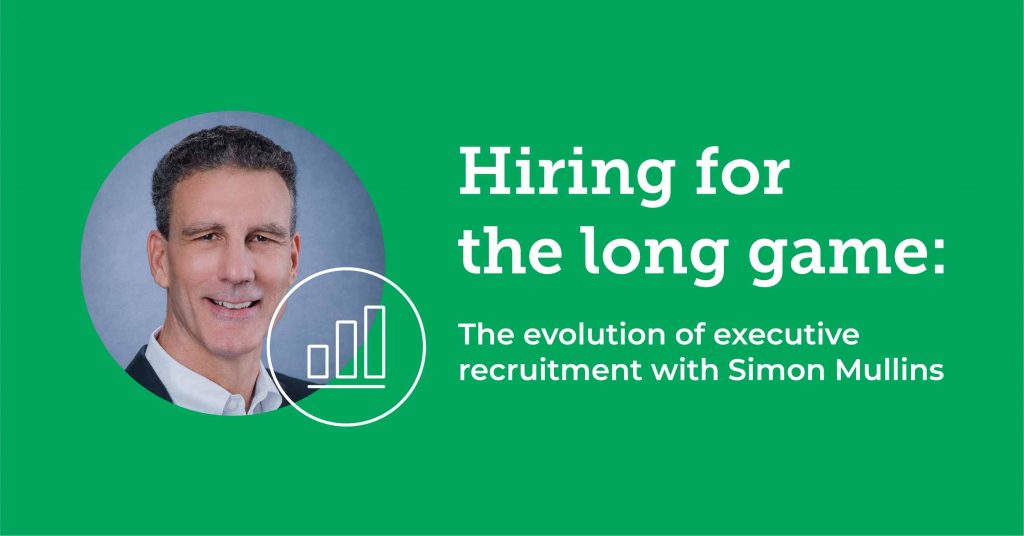
By David Deady
“Executive recruiters are like Heimdall, the watchman of the gods, from Norse mythology! We guard the future of our organizations – seeing around corners and clearing a path when that future comes calling.”
Simon Mullins
The function of executive recruitment has been continually evolving since its inception in a newly prospering, 1940s world. While it has remained true to this initial concept of searching for talent to fulfil high-level positions, the lens of executive recruitment has broadened. What is now considered ‘critical talent’ in organizations can relate to any number of specifications – not just seniority.
We recently had the pleasure of speaking to Simon Mullins, the author of Leadership Recruiting and the Chief Facilitator at ESIX (Executive Search Information Exchange.) A leading expert in the field of executive recruitment, Simon shared his valuable insights and expertise. We discuss everything from critical talent and the evergreen importance of DEI to the fundamental differences of the role compared to standard recruiting. Let’s dive in!

Recruiting vs. executive recruiting
According to Simon, in terms of the tactical or practical level, it comes down to the “high touch, white glove, low volume but high intensity” nature of executive recruiting that really sets it apart from standard recruiting. While the number of hires may be low, this massively belies the intense effort and long term vision. In specific relation to this, Simon talks about the need “to be available whenever the talent is ready to talk,” referring to the demanding time schedule and pressure. It’s exhilarating for sure, but when key roles are so critical to an organization, the stakes are much higher.
Time is also a fundamental factor for executive recruiters. It can often take up to five years from your first call with a candidate to an eventual hire. This isn’t always the case, but there can be no denying the greater need to map to the future. In some progressive companies, even, succession planning begins the day you make that critical hire. This long game approach requires nurturing and development of potential candidates across many facets. Simon believes that engagement like this is less reliant on the technology and processes that standard recruiting occupies, and more on the consulting skills, empathy and EQ of the particular executive searcher. These characteristics are vital tools to help establish connection and build these long term relationships.
Critical talent isn’t one-size-fits-all
Part of the challenge of modern executive recruiting is actually figuring out what critical talent is. The concept has evolved so much that, as Simon states, you are no longer looking for specific roles, but talent gaps in an organization. And these can encompass any number of different requirements.
“Critical talent doesn’t necessarily mean it has to be a ‘Chief Whatever Officer,’ it could be that it’s a space that is very critical to the organization. And that could be underrepresented groups or diverse groups or new talent in a new space. It’s less about a certain band of hiring and more about the strategic impact.”
The issue, according to Simon, is getting everyone to agree on what actually is priority. And how you manage that debate comes down to strong consulting skills and support from your management. This buy-in is fundamental for success, clarity and owning the future of the organization. Simon furthers this argument by saying that his job is sometimes about breaking glass – not like a hooligan, but precisely, like a glazier. Executive recruiters have to push boundaries on behalf of the greater good. They have to be opportunistic in order to best future-proof the organization.
The importance of diversity
It’s an issue that has to be woven into the very DNA of every single recruiter – how do you push the cause for diversity, equity and inclusion? And it’s no different in the realm of executive recruitment. According to a survey that ESIX performs every year in relation to organizational priorities, D&I regularly tops the poll by a wide margin. An encouraging stat, however, we know there is absolutely no silver bullet for success on this front. It’s a difficult process but, as stated by Simon, ‘this shouldn’t stop you trying.’
His advice is to take a holistic approach to diversity and ingrain it in every process of talent management, not just recruitment. Opt for ‘buy to build’ rather than ‘buy versus build,’ using executive recruitment methodology to bring in underrepresented groups at mid/senior levels allowing for change to occur from inside the company as well as from the top. He adds a word of caution though, stating that: “putting an underrepresented leader on a crystal matchstick pedestal is a risky business – especially if the new hire is to also be involved with ERGs and diversity sponsorship.” Ensure diversity, equity and inclusion is embedded into the culture, and don’t assume a single hire can solve the problem.
The last word
Simon left our discussion with one final pearl of wisdom – senior executives are often more interested in impact than compensation. Beautifully detailed documents, chronicling stock and benefits would often only receive cursory glances from potential hires. What really hit home was the legacy and impact they could have on products or markets or the company itself. This, according to Simon, is the key motivation to keep in mind as an executive recruiter. After that, the rest will fall into place.
Executive recruitment, or hiring for critical talent, plays a fundamental role in the success of a business. Its ability to push growth, innovation and social change cannot be overstated. Important talent, at all levels, is keenly connected to the performance and culture of an organization. So it’s absolutely worth getting it right.


